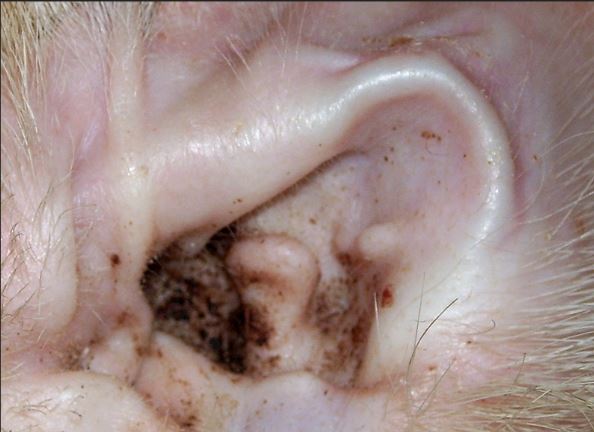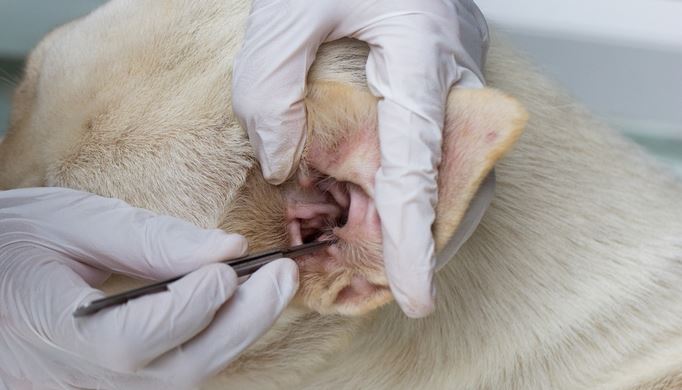Best ear mite treatment for dogs
Ear mites are not deadly but they cause great irritation to poor puppies and dogs. If your pooch is feeling uncomfortable and unpleased, ear mites might be the reason behind their discomfort.
Your furry friend might have ear mites so read on to learn more about what they are and how to deal with these irritating parasites.
What are ear mites in dogs?
Ear mites are tiny parasites that inhabit ear canals and surrounding skin. They are so small that you might haven’t noticed them yet. If you want to know how to check your pup for ear mites, you should look for the symptoms instead of the parasites.
Ear mites feed on the wax and oils in your dog’s ear canals and the result is scratching, head shaking, or rubbing of the ears.
Ear mites are only 1 to 2 centimeters long so it is nearly impossible to see them with a naked eye. To confirm if your pet has ear mites or not you should see a vet. A vet can diagnose ear mites infestation using a microscope or an otoscope and treat them more effectively.

Symptoms of ear mites in dogs
You should always look for the early signs and symptoms of ear mites. If your dog is not treated earlier the condition might get worse.
Ear mite symptoms are usually the same in puppies and older dogs. The following are some of the early signs and symptoms of ear mites that your dog might show:
- Skin irritation in and around the ears
- Scratching around the ears, neck and head
- Head shaking
- Dark and waxy ear discharge
- Foul smell from the ears and ear wax
Causes of ear mites in dogs
Ear mites are more common in puppies than in older dogs. The most common reason for ear mites is contact with other cats or dogs which are infested with ear mites. Ear mites can be easily transmitted from one animal to the other.
When one infested puppy or dog get onto bedding or play with other puppies or dogs, the mites easily make their move to a new host. So if your dog comes in contact with any other infected animal you should go seek a vet.
Prevention of ear mites in dogs
Prevention is always better than treatment. To prevent ear mites in dogs, vets recommend monthly dosage to keep dogs healthy and control ear mites.
The following are some other preventive measures that you should follow to keep your dog safe from infestation:
- Keep your dogs at distance from the ones who already have ear mites.
- Regularly wash your pet’s toys and bedding in hot water.
- After washing the bedding, give it a turn in a tumble dryer to get rid of all the mites hiding in it.
Treatment of ear mites in dogs
Visiting a vet is always a wise decision to treat ear mites in dogs and cats. Vets not only examine your dog’s ears but also look at a sample under a microscope to confirm the presence of ear mites. They also look for the presence of any secondary infection.
Medication for ear mites in dogs

When it comes to the treatment of ear mites in dogs, there are different kinds of medications. Your pet might prescribe you ear drops or other counter treatments like NexGard products.
Treatment for ear mites in puppies and adult dogs is usually the same. You must avoid using unproven home remedies for ear mites in dogs as they might not be effective. Any wrong treatment can make the situation worse. Therefore, it is important to use proven and effective ear mite treatments.
If you have any questions related to ear mites, you should speak to your vet for diagnosis and treatment options instead of browsing the internet or asking for the advice of a dog owner.
Some frequently asked questions about ear mites in dogs
Can a dog or cat owners get ear mites?
Although the transmission of parasites might look obvious, the good news is it is not the case. The likelihood of transmission of ear mites from cats or dogs to humans is very small. So you don’t need to be worried about the transmission but take some precautionary measures just in case.
Difference between dog ear mites and dog ear wax
An informed eye can differentiate between dog ear mites and dog ear wax very easily. Dogs usually have ear wax and it is completely normal. But an excessive amount of ear wax with unpleasant smell, redness, itchiness, shaking of the head, or excessive discharge might be early signs of ear mites. The best way to find out is to consult your vet because excessive wax might be a sign of other ear infections.
Difference between dog ear mites and dog ear infection
Discomfort in the ears is not always the sign of ear mites. Ear infections are also very common in dogs. These ear infections might be a bacterial infection, a yeast infection, or a secondary infection to an allergic skin disease.
As we have mentioned earlier, the best way to find out the root cause of your dog’s irritation is to consult with a vet. The vet can examine and find out the exact reason behind all the symptoms your dog is showing.

Can ear mites in dogs be painful?
Ear mites are not painful but they can cause extreme irritation and an urge to scratch. The continued scratching and rubbing can cause skin irritation and redness that lead to pain.
Can a dog have ear mites in one ear?
Usually, ear mites infest both ears. Sometimes, one ear may be more severely affected than the other one. If you have diagnosed ear mites in one ear only, chances are there that your dog might have them in the other ear also.

 The added benefit of the Purina Pro dog food is that it is made from 100% organic ingredients. It has actual pieces of salmon. Salmon is not only easier to digest than chunks of meat but filled with nutritious and health benefits for your dog. The variants of the Purina Pro are formulated with nutrients that specifically target your dog’s needs according to the size, stage of life and breed. Also, the dog food is obtainable in many different flavors that works well for dogs and ones that dogs seem to love – even picky eaters.
The added benefit of the Purina Pro dog food is that it is made from 100% organic ingredients. It has actual pieces of salmon. Salmon is not only easier to digest than chunks of meat but filled with nutritious and health benefits for your dog. The variants of the Purina Pro are formulated with nutrients that specifically target your dog’s needs according to the size, stage of life and breed. Also, the dog food is obtainable in many different flavors that works well for dogs and ones that dogs seem to love – even picky eaters.
 Dental treats are fun but also helpful in keeping your husky’s teeth pearly white. Food build up and all around bacteria can sit in between your husky’s teeth and eventually cause gum infections or sores.
Dental treats are fun but also helpful in keeping your husky’s teeth pearly white. Food build up and all around bacteria can sit in between your husky’s teeth and eventually cause gum infections or sores.